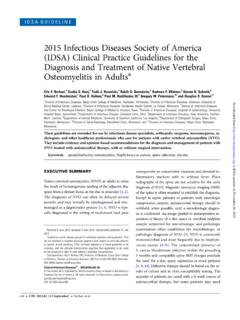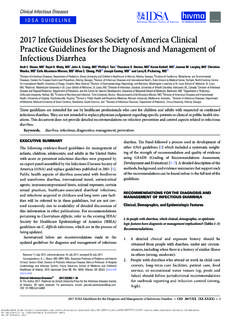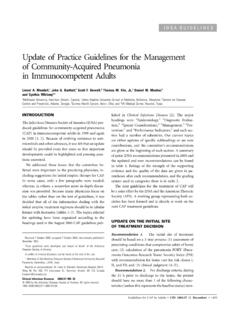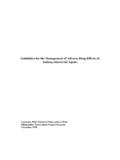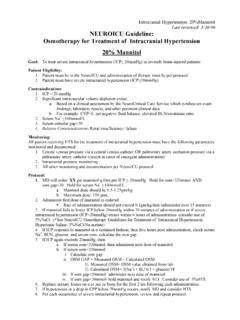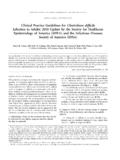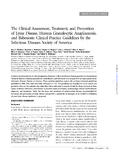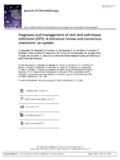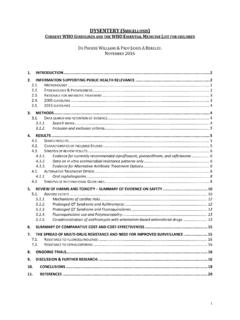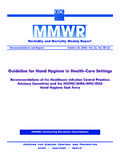Transcription of Clinical Infectious Diseases IDSA GUIDELINE
1 Clinical Infectious DiseasesIDSA GUIDELINEP ractice guidelines for the Diagnosis and Management ofAspergillosis: 2016 Update by the Infectious DiseasesSociety of AmericaThomas F. Patterson,1,aGeorge R. Thompson III,2 David W. Denning,3 Jay A. Fishman,4 Susan Hadley,5 Raoul Herbrecht,6 Dimitrios P. Kontoyiannis,7 Kieren A. Marr,8 Vicki A. Morrison,9M. Hong Nguyen,10 Brahm H. Segal,11 William J. Steinbach,12 David A. Stevens,13 Thomas J. Walsh,14 John R. Wingard,15Jo-Anne H. Young,16and John E. Bennett17,a1 University of Texas Health Science Center at San Antonio and South Texas Veterans Health Care System;2 University of California, Davis;3 National Aspergillosis Centre, University Hospital of SouthManchester, University of Manchester, United Kingdom;4 Massachusetts General Hospital and Harvard Medical School, and5 Tufts Medical Center, Boston, Massachusetts;6 University of Strasbourg,France;7 University of Texas MD Anderson Cancer Center, Houston;8 Johns Hopkins University School of Medicine and the Sidney Kimmel Comprehensive Cancer Center, Baltimore, Maryland;9 Hennepin County Medical Center and University of Minnesota, Minneapolis;10 University of Pittsburgh, Pennsylvania;11 University at Buffalo Jacobs School of Medicine and Biomedical Sciences, andRoswell Park Cancer Institute, New York;12 Duke University Medical Center, Durham, North Carolina;13 California Institute for Medical Research, San Jose.
2 14 New York Presbyterian Hospital/WeillCornell Medical Center, New York;15 University of Florida, Gainesville;16 University of Minnesota, Minneapolis;17 Laboratory of Clinical Infectious Diseases , National Institute of Allergy and InfectiousDisease, National Institutes of Health, Bethesda, MarylandIt is important to realize that guidelines cannot always account for individual variation among patients. They are not intended to sup-plant physician judgment with respect to particular patients or special Clinical situations. IDSA considers adherence to these guidelinesto be voluntary, with the ultimate determination regarding their application to be made by the physician in the light of each patient sindividual ; invasive aspergillosis; allergic aspergillosis; chronic aspergillosis; fungal diagnostics; azoles; echniocan-dins; SUMMARYB ackgroundAspergillusspecies continue to be an important cause of life-threatening infection in immunocompromised patients.
3 Thisat-risk population is comprised of patients with prolonged neu-tropenia, allogeneic hematopoietic stem cell transplant (HSCT),solid organ transplant (SOT), inherited or acquired immunode-ficiencies, corticosteroid use, and others. This document consti-tutes the guidelines of the Infectious Diseases Society ofAmerica (IDSA) for treatment of aspergillosis and replacesthe practice guidelines forAspergilluspublished in 2008. Sincethat publication, Clinical studies evaluating new and existingtherapies including combination therapy for the managementofAspergillusinfection have been conducted and the data onuse of non-culture-based biomarkers for diagnosing infectionhave been expanded. The objective of these guidelines is to sum-marize the current evidence for treatment of different forms ofaspergillosis. This document reviews guidelines for managementof the 3 major forms of aspergillosis: invasive aspergillosis (IA);chronic (and saprophytic) forms of aspergillosis; and allergicforms of aspergillosis.
4 Given the Clinical importance of IA, em-phasis is placed upon the diagnosis, treatment, and preventionof the different forms of IA, including invasive pulmonary asper-gillosis (IPA),Aspergillussinusitis, disseminated aspergillosis, andseveral types of single-organ below are the 2016 recommendations for themanagement of aspergillosis. Due to the guidelines relevanceto pediatrics, the GUIDELINE has been reviewed and endorsed bythe Pediatric Infectious Diseases Society (PIDS). The panelfollowed a GUIDELINE development process that has been adopt-ed by IDSA, which includes use of the Grading of Recommen-dations, Assessment, Development, and Evaluation (GRADE)system, a systematic method of grading both the strength ofthe recommendation (weak or strong) and the quality of evi-dence (very low, low, moderate, and high) (Figure1). Theguidelines are not intended to replace Clinical judgment inthe management of individual patients. A detailed descriptionof the methods, background, and evidence summaries thatsupport each recommendation can be found in the full textof the AND RISK FACTORS FORINFECTIONI.
5 How Can the Most Susceptible Patients Be Protected FromAspergillosis, and Which Patients Are Most Susceptible?What Are Sources of Exposure to Aspergillus, and How CanExposure Be Decreased? Is Environmental Surveillance Useful?Received 7 May 2016; accepted 11 May F. P. and J. E. B. served as co-chairs for the IDSAA spergillusGuidelines : T. F. Patterson, Division of Infectious Diseases , San Antonio Center for Med-ical Mycology, The University of Texas Health Science Center at San Antonio, 7703 Floyd CurlDrive MSC 7881, San Antonio, TX 78229-3900 Infectious Diseases Published by Oxford University Press for the Infectious Diseases Society of America 2016. Thiswork is written by (a) US Government employee(s) and is in the public domain in the : guidelines for the Diagnosis and Management of Aspergillosis CID 1 Clinical Infectious Diseases Advance Access published June 29, 2016 by Paul Edelstein on July 3, 2016 from Hospitalized allogeneic HSCT recipients should be placed ina protected environment to reduce mold exposure(strongrecommendation; low-quality evidence).
6 2. These precautions can be reasonably applied to otherhighly immunocompromised patients at increased risk for IA,such as patients receiving induction/reinduction regimens foracute leukemia(strong recommendation; low-quality evidence).3. In hospitals in which a protected environment is not avail-able, we recommend admission to a private room, no con-nection to construction sites, and not allowing plants orcutflowers to be brought into the patient s room(strong rec-ommendation; low-quality evidence).4. We recommend reasonable precautions to reduce mold ex-posure among outpatients at high risk for IA, includingavoidance of gardening, spreading mulch (compost), orclose exposure to construction or renovation(strong recom-mendation; low-quality evidence).5. Leukemia and transplant centers should performregular surveillance of cases of invasive mold infection. Anincrease in incidence over baseline or the occurrence of inva-sive mold infections in patients who are not at high risk forsuch infections should prompt evaluation for a hospitalsource (strong recommendation; low-quality evidence).
7 DIAGNOSIS OF ASPERGILLOSISII. How Can a Diagnosis of Invasive Aspergillosis Be Established?How Should Aspergillus Be Identified, and How Does ThisInfluence Management? Until molecular tools are more widely used in Clinical labo-ratories, we recommend that tissue andfluid specimens besubmitted in adequate quantities for simultaneous histopath-ologic/cytologic and culture examination. In the case of iso-lates with atypical growth or concerns for resistance, speciesFigure and implications to rating the quality of evidence and strength of recommendations using the Grading of Recommendations, Assessment, Development,and Evaluation (GRADE) methodology (unrestricted use of the figure granted by the US GRADE Network) [4].2 CID Patterson et al by Paul Edelstein on July 3, 2016 from identification by molecular methods should be employed(strong recommendation; high-quality evidence).What Is the Diagnostic Value of Nucleic Acid Testing in ClinicalSpecimens? There was debate among the committee members regardingthe Clinical utility of blood-based polymerase chain reaction(PCR) in diagnosing IA, and experts were not in group favored recommendations for PCR testing, basedon publications validating its role when used in conjunctionwith other tests such as antigen detection assays to diagnoseIA and/or reduce preemptive antifungal usage.
8 The othergroup thought that PCR assays are promising but could notbe recommended for routine use in Clinical practice at presentdue to the lack of conclusive validation for commercially avail-able assays, the variety of methodologies in the literature, andquestions about the extent to which results assisted As research in the area continues, we recommend that clinicianschoosing to use PCR assays employ them carefully in the man-agement of individual patients on a case-by-case basis. Clini-cians should be aware of the methodologies and performancecharacteristics of the specific assay used, and interpret results ac-cordingly. When PCR assays are used, results should be consid-ered in conjunction with other diagnostic tests and the clinicalcontext(strong recommendation; moderate-quality evidence).How Should Galactomannan and (1!3)- -D-Glucan Be Used forthe Diagnosis of Aspergillosis? Serum and BAL galactomannan (GM) is recommended asan accurate marker for the diagnosis of IA in adult and pe-diatric patients when used in certain patient subpopulations(hematologic malignancy, HSCT)(strong recommendation;high-quality evidence).
9 10. GM is not recommended for routine blood screening in pa-tients receiving mold-active antifungal therapy or prophylaxis,but can be applied to bronchoscopy specimens from those pa-tients(strong recommendation; high-quality evidence).11. GM is not recommended for screening in SOT recipients orpatients with chronic granulomatous disease (CGD)(strongrecommendation; high-quality evidence).12. Serum assays for (1 3)- -D-glucan are recommendedfor diagnosing IA in high-risk patients (hematologic malig-nancy, allogeneic HSCT), but are not specific forAspergillus(strong recommendation; moderate-quality evidence).What Is the Approach to the Radiographic Diagnosis of InvasivePulmonary Aspergillosis? We recommend performing a chest computed tomograph-ic (CT) scan whenever there is a Clinical suspicion for IPAregardless of chest radiograph results (strong recommenda-tion; high-quality evidence).14. Routine use of contrast during a chest CT scan for a sus-picion of IPA is not recommended (strong recommendation;moderate-quality evidence).
10 Contrast is recommended whena nodule or a mass is close to a large vessel (strong recommen-dation; moderate-quality evidence).15. We suggest a follow-up chest CT scan to assess the responseof IPA to treatment after a minimum of 2 weeks of treatment;earlier assessment is indicated if the patient clinically deterio-rates (weak recommendation; low-quality evidence).When anodule is close to a large vessel, more frequent monitoringmay be required (weak recommendation; low-quality evidence).What Is the Role of Bronchoscopy in the Diagnosis of InvasivePulmonary Aspergillosis? We recommend performing a bronchoscopy with bron-choalveolar lavage (BAL) in patients with a suspicion of IPA(strong recommendation; moderate-quality evidence).Signifi-cant comorbidities such as severe hypoxemia, bleeding, andplatelet transfusion-refractory thrombocytopenia may pre-clude BAL. The yield of BAL is low for peripheral nodular le-sions, so percutaneous or endobronchial lung biopsy shouldbe considered.
